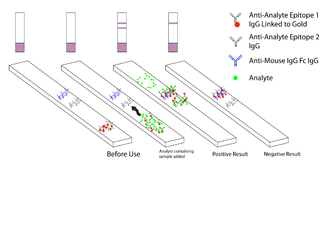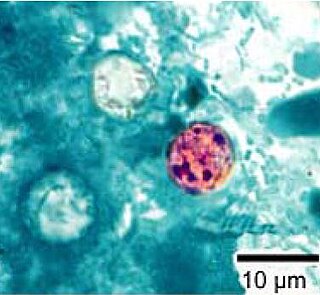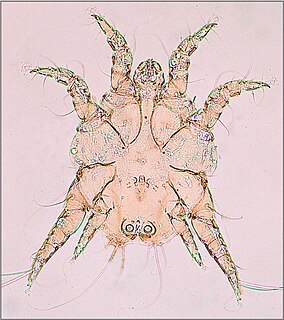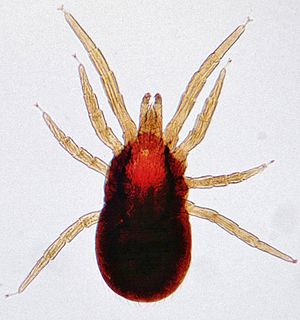Related Research Articles

Parasitism is a symbiotic relationship between species, where one organism, the parasite, lives on or inside another organism, the host, causing it some harm, and is adapted structurally to this way of life. The entomologist E. O. Wilson has characterised parasites as "predators that eat prey in units of less than one". Parasites include single-celled protozoans such as the agents of malaria, sleeping sickness, and amoebic dysentery; animals such as hookworms, lice, mosquitoes, and vampire bats; fungi such as honey fungus and the agents of ringworm; and plants such as mistletoe, dodder, and the broomrapes. There are six major parasitic strategies of exploitation of animal hosts, namely parasitic castration, directly transmitted parasitism, trophically transmitted parasitism, vector-transmitted parasitism, parasitoidism, and micropredation.

Plasmodium is a genus of unicellular eukaryotes that are obligate parasites of vertebrates and insects. The life cycles of Plasmodium species involve development in a blood-feeding insect host which then injects parasites into a vertebrate host during a blood meal. Parasites grow within a vertebrate body tissue before entering the bloodstream to infect red blood cells. The ensuing destruction of host red blood cells can result in disease, called malaria. During this infection, some parasites are picked up by a blood-feeding insect, continuing the life cycle.

Babesiosis or piroplasmosis is a malaria-like parasitic disease caused by infection with a eukaryotic parasite in the order Piroplasmida, typically a Babesia or Theileria, in the phylum Apicomplexa. Human babesiosis transmission via tick bite is most common in the Northeastern and Midwestern United States and parts of Europe, and sporadic throughout the rest of the world. It occurs in warm weather. People can get infected with Babesia parasites by the bite of an infected tick, by getting a blood transfusion from an infected donor of blood products, or by congenital transmission . Ticks transmit the human strain of babesiosis, so it often presents with other tick-borne illnesses such as Lyme disease. After trypanosomes, Babesia is thought to be the second-most common blood parasite of mammals. They can have major adverse effects on the health of domestic animals in areas without severe winters. In cattle the disease is known as Texas cattle fever or redwater.

The European mole is a mammal of the order Eulipotyphla. It is also known as the common mole and the northern mole.

Plasmodium knowlesi is a parasite that causes malaria in humans and other primates. It is found throughout Southeast Asia, and is the most common cause of human malaria in Malaysia. Like other Plasmodium species, P. knowlesi has a life cycle that requires infection of both a mosquito and a warm-blooded host. While the natural warm-blooded hosts of P. knowlesi are likely various Old World monkeys, humans can be infected by P. knowlesi if they are fed upon by infected mosquitoes. P. knowlesi is a eukaryote in the phylum Apicomplexa, genus Plasmodium, and subgenus Plasmodium. It is most closely related to the human parasite Plasmodium vivax as well as other Plasmodium species that infect non-human primates.

Babesia, also called Nuttallia, is an apicomplexan parasite that infects red blood cells and is transmitted by ticks. Originally discovered by the Romanian bacteriologist Victor Babeș, over 100 species of Babesia have since been identified.

Malaria antigen detection tests are a group of commercially available rapid diagnostic tests of the rapid antigen test type that allow quick diagnosis of malaria by people who are not otherwise skilled in traditional laboratory techniques for diagnosing malaria or in situations where such equipment is not available. There are currently over 20 such tests commercially available. The first malaria antigen suitable as target for such a test was a soluble glycolytic enzyme Glutamate dehydrogenase. None of the rapid tests are currently as sensitive as a thick blood film, nor as cheap. A major drawback in the use of all current dipstick methods is that the result is essentially qualitative. In many endemic areas of tropical Africa, however, the quantitative assessment of parasitaemia is important, as a large percentage of the population will test positive in any qualitative assay.

Leucocytozoon is a genus of parasitic alveolates belonging to the phylum Apicomplexa.

Dermanyssus gallinae is a haematophagous ectoparasite of poultry. It has been implicated as a vector of several major pathogenic diseases. Despite its common names, it has a wide range of hosts including several species of wild birds and mammals, including humans. In both size and appearance, it resembles the northern fowl mite, Ornithonyssus sylviarum.

Haemoproteus is a genus of alveolates that are parasitic in birds, reptiles and amphibians. Its name is derived from Greek: Haima, "blood", and Proteus, a sea god who had the power of assuming different shapes. The name Haemoproteus was first used in the description of Haemoproteus columbae in the blood of the pigeon Columba livia by Kruse in 1890. This was also the first description of this genus. Two other genera — Halteridium and Simondia — are now considered to be synonyms of Haemoproteus.
Karyolysus is a genus of coccidia. With the exception of K. sonomae whose vertebrate host is the yellow-legged frog, species in this genus only infect lizards of the genus Lacerta.
The genus Polychromophilus consists of obligate intracellular eukaryotic parasites that infect bats from every continent except Antarctica. They are transmitted by bat flies, which act as an insect vector as well as the parasite’s site of sporogeny. Polychromophilus follows a fairly typical Haemospororidian lifecycle, with gametocytes and gametes restricted to the bloodstream of the host and meronts infecting organs – most notably the lungs and the liver. The type species is Polychromophilus melanipherus, and was described by Dionisi in 1898.
Nycteria is a genus of protozoan parasites that belong to the phylum Apicomplexa. It is composed of vector-borne haemosporidian parasites that infect a wide range of mammals such as primates, rodents and bats. Its vertebrate hosts are bats. First described by Garnham and Heisch in 1953, Nycteria is mostly found in bat species where it feeds off the blood of their hosts and causes disease. Within the host, Nycteria develops into peculiar lobulated schizonts in parenchyma cells of the liver, similarly to the stages of Plasmodum falciparum in the liver. The vector of Nycteria has been hard to acquire and identify. Because of this, the life cycle of Nycteria still remains unknown and understudied. It has been suggested that this vector could be an arthropod rather than a mosquito or the vector of most haemosporidian parasites.
Achromatorida is an order of non-pigmented intraerythrocytic parasitic alveolates belonging to the subclass Haemosporidiasina. The order was created by Jacques Euzéby in 1988.

Cyclospora is a genus of apicomplexan parasites. It includes the species Cyclospora cayetanensis, the causative agent of cyclosporiasis. Members of Cyclospora are characterized as having oocysts with two sporocysts, each containing two sporozoites.

Mites that infest and parasitize domestic animals cause disease and loss of production. Mites are small invertebrates, most of which are free living but some are parasitic. Mites are similar to ticks and both comprise the order Acari in the phylum Arthropoda. Mites are highly varied and their classification is complex; a simple grouping is used in this introductory article. Vernacular terms to describe diseases caused by mites include scab, mange, and scabies. Mites and ticks have substantially different biology from, and are classed separately from, insects. Mites of domestic animals cause important types of skin disease, and some mites infest other organs. Diagnosis of mite infestations can be difficult because of the small size of most mites, but understanding how mites are adapted to feed within the structure of the skin is useful.
Nova virus is a single-stranded, negative-sense, enveloped RNA orthohantavirus. It is phylogenetically related to other European and Asian hantaviruses that cause hantavirus hemorrhagic fever with renal syndrome. No known human cases of infection have been reported.

Mites are small crawling animals related to ticks and spiders. Most mites are free-living and harmless. Other mites are parasitic, and those that infest livestock animals cause many diseases that are widespread, reduce production and profit for farmers, and are expensive to control.
Plasmodium cynomolgi is an apicomplexan parasite that infects mosquitoes and Asian Old World monkeys. This species has been used as a model for human Plasmodium vivax because Plasmodium cynomolgi shares the same life cycle and some important biological features with P. vivax.
References
- ↑ Graham-Smith GS (1905). "A New Form of Parasite found in the Red Blood Corpuscles of Moles". J Hyg (Lond). 5 (4): 453–9. doi:10.1017/S0022172400006768. JSTOR 3858956. PMC 2236097 . PMID 20474234.
- ↑ Mohamed HA, Molyneux DH (1984). "Elleipsisoma thomsoni Franca, 1912: an Apicomplexan parasite in the red blood cells of the mole (Talpa europaea)". Parasitology. 89 (3): 407–415. doi:10.1017/S0031182000056651. PMID 6514376.
- ↑ Mohamed HA, Molyneux DH, Wallbanks KR (1987). "A coccidian in haemogamasid mites; possible vectors of Elleipsisoma thomsoni Franca, 1912". Ann Parasitol Hum Comp. 62 (2): 107–116. doi: 10.1051/parasite/1987622107 . PMID 3592490.
| | This Apicomplexa-related article is a stub. You can help Wikipedia by expanding it. |